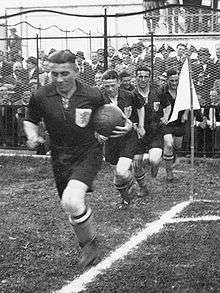Puck van Heel
 Van Heel (front) playing for the Netherlands national football team in the 1934 World Cup. | |||
| Personal information | |||
|---|---|---|---|
| Full name | Gerardus Henricus van Heel | ||
| Date of birth | 21 January 1904 | ||
| Place of birth | Rotterdam, Netherlands | ||
| Date of death | 18 December 1984 (aged 80) | ||
| Place of death | Rotterdam, Netherlands | ||
| Playing position | Midfielder | ||
| Youth career | |||
| 1919–1923 | Feijenoord | ||
| Senior career* | |||
| Years | Team | Apps | (Gls) |
| 1923–1940 | Feijenoord | 322 | (43) |
| National team‡ | |||
| 1925–1938 | Netherlands[1][2][3] | 64 | (0) |
|
* Senior club appearances and goals counted for the domestic league only and correct as of 6 June 2007. | |||
Gerardus Henricus "Puck" van Heel (21 January 1904 – 19 December 1984) was a Dutch footballer born in Rotterdam. He earned 64 caps for the Netherlands national football team, and played in the 1934 and 1938 World Cups. During his club career, he played for his home town club of Feyenoord. Normally an inside left and left wing half, Van Heel was a slow player but possessed considerable vision and technical ability and was particularly good passer.
He held the Dutch caps record from 4 April 1937[3][4](when he equaled the total of Harry Dénis) until 22 May 1979 (when his total was surpassed by Ruud Krol).[3][5]
Van Heel was born on the southside of Rotterdam, the fourth of eleven children, into a Roman Catholic family. His father worked in the shipyards of Rotterdam.[2][6] He joined the amateur club Sportclub Feyenoord, a youth academy for Feyenoord Rotterdam, and made his amateur debut in the red and white on 12 October 1919.
Playing career
Van Heel was a cornerstone of the Feyenoord success preceding World War II, winning five Dutch Eredivisie Championships and two KNVB Cups. During his time there, he became the team captain and a figurehead for the club.[2] He was also one of the 11 Feyenoord players, (Adri van Male, Pleun de Groot, Joop van der Heide, Bas Paauwe, Gerard Kuppen, van Heel, Jan Linssen, Piet Smits, Manus Vrauwdeunt, Leen Vente, Piet Kantebeen) chosen to play at the inauguration of their new stadium on 27 March 1937. The stadium was christened Feijenoord Stadion but would become known as "De Kuip". The game was against Belgian side Beerschot and watched by 37,825 spectators. Feyenoord were runaway victors with a final scoreline of 5–2.
Van Heel earned his first international cap at 21 years of age, on 19 April 1925.[3] He would be part of the Dutch team for the next 13 years, until his retirement from international duty on 23 October 1938. His final game, a 2–2 draw with Denmark, would be his 64th cap for the Dutch national side.[3] He equaled Harry Dénis's record of 56 caps on 4 April 1937[7] and would earn his 57th on 2 May 1937, both of these games were against Belgium.[3] He would remain the most capped Dutch player until 1979 when Ruud Krol would exceed his total.[8]
Van Heel played in the 1934[9] and 1938[10] FIFA World Cups under British manager Bob Glendenning.
Career honours
Club
Feyenoord
- Eredivisie
- Winner (5): 1923-24, 1927–28, 1935–36, 1937–38, 1939–40
- Runner-up (4): 1930-31, 1931–32, 1932–33, 1936–37
- KNVB Cup
- Winner (3): 1930, 1935
- Runner-up (1): 1934
International
References
- ↑ "Puck van Heel - Profile at Voetbalstats.nl" (in Dutch). Voetbalstats.nl. Archived from the original on 24 June 2008. Retrieved 16 December 2008.
- 1 2 3 "Puck van Heel - Feyenoord Profile" (in Dutch). Retrieved 16 December 2008.
- 1 2 3 4 5 6 "Puck van Heel - International Appearances". RSSSF. 15 January 2005. Retrieved 16 December 2008.
- ↑ 1937 in association football
- ↑ "Dé record internationals van Oranje" (in Dutch). Voetbalstats.nl. Archived from the original on 27 June 2008. Retrieved 16 December 2008.
- ↑ "Puck Van Heel Biography" (in Dutch). Retrieved 16 December 2008.
- ↑ "Harry Dénis - International Appearances". RSSSF. 23 January 2005. Retrieved 16 December 2008.
- ↑ "Ruud Krol - International Appearances". RSSSF. 6 February 2008. Retrieved 16 December 2008.
- ↑ 1934 FIFA World Cup squads
- ↑ 1938 FIFA World Cup squads